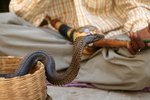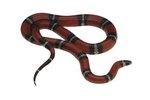
Common from the Horn of Africa to Namibia, the black mamba (Dendroaspis polylepis) has a reputation as the world’s deadliest snake. This feared and respected snake is not black; rather, its name comes from the inside of its mouth, revealed by a threatened mamba on the verge of striking. The subject of local myths and legends, black mambas prefer wooded areas and rocky hills with ample cover. Reaching lengths of up to 14 feet, the black mamba is Africa’s longest venomous snake.
Venomous Bite
While the black mamba only bites as a last resort when cornered and unable to flee, the snake is most known and feared for the toxicity of its venom. A black mamba strikes not once but repeatedly, its fangs delivering a lethal combination of neurotoxins and cardiotoxins. Just two drops of this venom will paralyze and stop the heart of the snake’s victim. Before antivenin was available, a black mamba bite was 100 percent fatal within 20 minutes of the attack.
Avoidance
The black mamba’s most practiced means of protection is avoidance. Though its potent venom earned it a deadly reputation, these snakes are shy and secretive, almost always seeking to escape rather than attack when confronted. Black mambas generally avoid human settlements and are unlikely to enter peoples’ homes.
Speed
Equipped to master its avoidance technique, the black mamba is among the fastest snakes in the world. Across short distances black mambas can move at speeds up to 12 mph. The snake glides across surfaces with up to a third of its body not even touching the ground. They are also agile climbers, slithering quickly up trees to evade threats or would-be predators.
Solitary Nature
Black mambas are not social creatures, nor are they territorial. While other animals may get injured or killed defending their territory or their young, black mambas prefer to stay out of harm’s way. The only time these snakes engage each other in combat is during mating season; they do not associate with each other at any other time. Neither the male nor the female raises the offspring or defends the nest. After the female lays eggs, she abandons them, never to return. Hatchlings are born on their own and must fend for themselves from birth.
References
Resources
Photo Credits
-
Hemera Technologies/AbleStock.com/Getty Images
Writer Bio
Jennifer Mueller began writing and editing professionally in 1995, when she became sports editor of her university's newspaper while also writing a bi-monthly general interest column for an independent tourist publication. Mueller holds a Bachelor of Arts in political science from the University of North Carolina at Asheville and a Juris Doctor from Indiana University Maurer School of Law.




